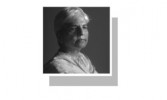TOMORROW is Dec 16. Not many in present-day Pakistan, where the majority was born after the country had lost its eastern wing, are aware of the significance of this date. How would they when they have not been told about it? Social studies textbooks taught in colleges give a simplistic account of how political negotiations between PPP and Awami League leaders after the 1970 polls ended in stalemate. Thereafter the country broke up due to India’s “naked aggression” and “imperialistic designs” in the words of Gen Yahya Khan, following the fall of Dhaka. End of story.
With so much having been written (though not in textbooks) about the emergence of Bangladesh, I will not take the well-trodden path. There may be differences of opinion on the details but there is consensus that, from the start, the military and civil establishment, as well as policymakers in West Pakistan, discriminated against East Pakistan. In Dr Tariq Rahman’s excellent book Pakistan’s Wars, Bengali economists described the situation as “internal colonialism” and the “flow of capital from east to west”. He has given examples of how West Pakistani officials stationed in East Pakistan heaped humiliation on the locals. The Hamoodur Rahman Commission Report, covering the strategic dimension, completes the account of this tragedy.
What has intrigued me all these years afterwards is why no social integration took place at the people’s level. The Bengalis were ethnically, culturally and linguistically homogeneous and the number of outsiders relatively small. Those who migrated in the early years — 1947-1950 — fall into three categories. First were the Muslim civil servants who, when officially given the choice, opted for Pakistan. Their postings in East Bengal were determined by the proximity factor. Second, Muslim masses in eastern UP and Bihar who decided to move to Pakistan went to the eastern wing as it was closer to their ancestral homes. Third, many Muslims from West Bengal were forced to leave, against their will, after riots in Calcutta.
The first category had the same attitude vis-à-vis the native population as their colleagues from West Pakistan in Dhaka and other cities. As for the other non-Bengalis, they believed in the superiority of their language and culture. This prevented them from learning Bangla and intermingling with the local population. They may not have been as openly contemptuous in their dealings as those in positions of authority, but their attitude towards their hosts was enough to horrify me, a visitor from the western wing, who stayed in Chittagong with relatives for four months in 1970 when tensions were running high.
From the start, East Pakistan was discriminated against.
My observations as well as interviews with non-Bengalis confirms this view. The West Pakistan-dominated administration encouraged this callous attitude. Urdu-medium schools were opened for Urdu speakers where the Bengali language was not even taught. No facilities were made available to teach Bengali to those who didn’t know the language. We know what impact language has on society and the bonding of people. The fallout of Mr Jinnah’s statement in 1948 in Dhaka about Urdu alone being the national language should not be underestimated. Even the inclusion of Bengali as a national language along with Urdu in the 1956 constitution could not atone for the original hurt.
Surprisingly, the West Bengalis also failed to assimilate. Most of them were highly educated and looked down upon their ‘country cousins’ from the eastern side of the Radcliffe Line. They communicated in English or Urdu.
There was a miniscule number of Biharis who grew up in East Pakistan whose families allowed them to intermingle with their neighbours. They spoke Bengali fluently and had Bengali friends. But in the environment of ethnic hatred that had gripped the country in 1970, these few loyalists met a fate similar to that of their compatriots. A doctor now residing in America after spending his childhood in East Pakistan tells me that when the hour of reckoning came he became as vulnerable as any other Bihari and it was his Bengali friends who smuggled him out of Bangladesh in 1972 to Nepal from where he reached Karachi.
Nothing captures more poignantly the paradox of our ties with East Pakistan before 1971 than Naseer Turabi’s poem Hamsafar, the lines reflecting the lack of camaraderie and sharing with one’s fellow traveller.
NB: Mea culpa. In my last column, I had given the number of libraries set up under the Room to Read project incorrectly. It should be: 24 stand-alone and 60 classroom libraries.
www.zubeida-mustafa.com
Published in Dawn, December 15th, 2023





















 Toi Staff
Toi Staff Gideon Levy
Gideon Levy Belen Fernandez
Belen Fernandez Andrew Mitrovica
Andrew Mitrovica Mort Laitner
Mort Laitner Ali Fathollah-Nejad
Ali Fathollah-Nejad Rami G Khouri
Rami G Khouri Nikkei Editorial
Nikkei Editorial
